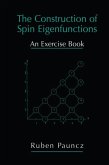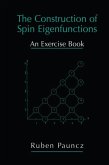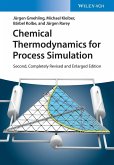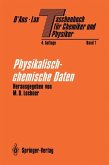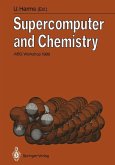William H. Cropper
Mathematica® Computer Programs for Physical Chemistry
William H. Cropper
Mathematica® Computer Programs for Physical Chemistry
- Broschiertes Buch
- Merkliste
- Auf die Merkliste
- Bewerten Bewerten
- Teilen
- Produkt teilen
- Produkterinnerung
- Produkterinnerung
Physical chemistry requires extensive problem-solving and lengthy calculations. This book brings the computational power and elegance of Mathematica to physical chemistry courses. The book is organized along the lines of most modern physical chemistry textbooks. It discusses the kinds of problems encountered in each area of physical chemistry, and includes worked examples. An appendix outlines the calculations that are important in physical chemistry and demonstrates how they are handled in Mathematica code. The book is an ideal complement to any physical chemistry text and will be welcomed by students and instructors alike.…mehr
Andere Kunden interessierten sich auch für
![The Construction of Spin Eigenfunctions The Construction of Spin Eigenfunctions]() Ruben PaunczThe Construction of Spin Eigenfunctions83,99 €
Ruben PaunczThe Construction of Spin Eigenfunctions83,99 €![Density Functional Theory II Density Functional Theory II]() Density Functional Theory II115,99 €
Density Functional Theory II115,99 €![The Construction of Spin Eigenfunctions The Construction of Spin Eigenfunctions]() Ruben PaunczThe Construction of Spin Eigenfunctions83,99 €
Ruben PaunczThe Construction of Spin Eigenfunctions83,99 €![Surface and Colloid Science in Computer Technology Surface and Colloid Science in Computer Technology]() Kashmiri Lal MittalSurface and Colloid Science in Computer Technology92,99 €
Kashmiri Lal MittalSurface and Colloid Science in Computer Technology92,99 €![Chemical Thermodynamics for Process Simulation Chemical Thermodynamics for Process Simulation]() Jürgen GmehlingChemical Thermodynamics for Process Simulation81,99 €
Jürgen GmehlingChemical Thermodynamics for Process Simulation81,99 €![Taschenbuch für Chemiker und Physiker Taschenbuch für Chemiker und Physiker]() Jean d' AnsTaschenbuch für Chemiker und Physiker119,99 €
Jean d' AnsTaschenbuch für Chemiker und Physiker119,99 €![Supercomputer and Chemistry Supercomputer and Chemistry]() Supercomputer and Chemistry77,99 €
Supercomputer and Chemistry77,99 €-
-
-
Physical chemistry requires extensive problem-solving and lengthy calculations. This book brings the computational power and elegance of Mathematica to physical chemistry courses. The book is organized along the lines of most modern physical chemistry textbooks. It discusses the kinds of problems encountered in each area of physical chemistry, and includes worked examples. An appendix outlines the calculations that are important in physical chemistry and demonstrates how they are handled in Mathematica code. The book is an ideal complement to any physical chemistry text and will be welcomed by students and instructors alike.
Produktdetails
- Produktdetails
- Verlag: Springer, Berlin
- 1998.
- Seitenzahl: 260
- Erscheinungstermin: 3. April 1998
- Englisch
- Abmessung: 235mm x 155mm x 15mm
- Gewicht: 412g
- ISBN-13: 9780387983370
- ISBN-10: 0387983376
- Artikelnr.: 07489968
- Herstellerkennzeichnung
- Springer-Verlag GmbH
- Tiergartenstr. 17
- 69121 Heidelberg
- ProductSafety@springernature.com
- Verlag: Springer, Berlin
- 1998.
- Seitenzahl: 260
- Erscheinungstermin: 3. April 1998
- Englisch
- Abmessung: 235mm x 155mm x 15mm
- Gewicht: 412g
- ISBN-13: 9780387983370
- ISBN-10: 0387983376
- Artikelnr.: 07489968
- Herstellerkennzeichnung
- Springer-Verlag GmbH
- Tiergartenstr. 17
- 69121 Heidelberg
- ProductSafety@springernature.com
1. Preliminaries.- 1.1 Uncertainties and Units: Error.- 1.2 Gas Laws: Anderko, Beattie, Keenan1, Peng1, Virial1, Virial2, Waals.- 1.3 Data Fitting.- 1.4 Exercises.- 2. Chemical Thermodynamics in Theory.- 2.1 At High Temperatures: Deltag1, Deltag2, Deltag3.- 2.2 At High Temperatures and High Pressures: Gplot, Hp lot, Keenan2, Peng2, Peng3, Splot, Zplot.- 2.3 Calorimetric Entropies: Debye, Entropy.- 2.4 Partial Molar Quantities: Rho.- 2.5 Chemical Potential Theory.- 2.6 Ideal Solutions: Henry, Raoult.- 2.7 Nonideal Solutions: Pitzer, Vanlaar.- 2.8 Chemical Equilibrium Theory: Gibbs, Vanthoff.- 2.9 Exercises.- 3. Chemical Thermodynamics in Use.- 3.1 Geochemical Thermodynamics: Powell.- 3.2 Ordinary Equilibrium Calculations: Acetate, Coal, Haber, Na2Co3, Tcurve.- 3.3 Biochemical Thermodynamics: Atpl, Atp2, Biochem, Gprofile.- 3.4 Exercises.- 4. Quantum Theory.- 4.1 Schrödinger Equations.- 4.2 The Schrödinger Equation Solved: Schroed1, Schroed2, Schroed3, Well.- 4.3 Orbitals: Aorbital, Duality, Morbital.- 4.4 Molecular Mechanics.- 4.5 Energy Levels: Abc, Morse, Ro1, Ro2, Rovil, Viel1.- 4.6 The Hartee-Fock Equation.- 4.7 Matrix Equations: Hartree, Hueckel.- 4.8 Exercises.- 5. Spectroscopy.- 5.1 Rotational Spectroscopy: Ro3.- 5.2 Rotational-Vibrational Spectroscopy: Peaks, Rovi2, Symtop1, Symtop2.- 5.3 Vibrational-Electronic Spectroscopy: viel2.- 5.4 Rotational-Vibrational-Electronic Spectroscopy: Roviel.- 5.5 Magnetic Resonance Spectroscopy: Esr, Nmr, 2dnmr.- 5.6 Fourier-Transform Methods: Irft, Nmrft.- 5.7 Exercises.- 6. Solids, Liquids, and Surfaces.- 6.1 X-Ray Crystallography: Pattersn, Powder, Xray1, Xray2, Xray3, Xray4.- 6.2 Electron Diffraction in Gases: Elecdiff.- 6.3 Semiconductors: Fermi.- 6.4 Molecular Dynamics Simulations of Liquids: MD1, MD2, MD3 (QuickBASIC Programs).- 6.5 Monte Carlo Simulations of Liquids: MC1, MC2 (QuickBASIC Programs).- 6.6 Electrical Properties of Solid Surfaces: Gouy1, Gouy2, Gouy3.- 6.7 Surface Crystallography: Leed.- 6.8 Exercises.- 7. Macromolecules.- 7.1 Random Coils: Coil1, Coil2, Coil3.- 7.2 Macromolecules as Hydrodynamic Particles.- 7.3 Diffusion: Perrin1, Perrin2.- 7.4 Viscometry: Simha1, Simha2.- 7.5 Macromolecules as Light-Scattering Particles: Zimm.- 7.6 Exercises.- 8. Statistical Thermodynamics.- 8.1 General Methods: Mixing.- 8.2 Partition Functions: Zelec, Zrot, Zvib.- 8.3 Partition-Function Thermodynamics: Statcalc.- 8.4 Refinements: Chase.- 8.5 Statistical Chemical Thermodynamics: Statk.- 8.6 Nuclear-Spin Statistics: Cpd2, Cph2, Cphd, Statg, S&mud2, S&muh2, S&muhd.- 8.7 Exercises.- 9. Physical Kinetics.- 9.1 Maxwell's Distribution Function: Maxwell1, Maxwell2.- 9.2 Molecular Collisions: Collide.- 9.3 Diffusion: Diffuse1, Diffuse2.- 9.4 Ions in Motion: Lambda, Onsager.- 9.5 Exercises.- 10. Chemical Kinetics in Use.- 10.1 Chemical Kinetics: Chemkin, Xss.- 10.2 Complex Reaction Systems: Branch, Catcycle, Cycle, Krebs.- 10.3 Polymerization Kinetics: Chain, Step.- 10.4 Biological Kinetics: Biokin.- 10.5 Biophysical Kinetics: Hodgkin, Kgating, Nagating.- 10.6 Exercises.- 11. Chemical Kinetics in Theory.- 11.1 Reactions in Beams: Newton.- 11.2 Potential Energy Surfaces: Leps.- 11.3 Activated-Complex Theory: Eyring1, Eyring2.- 11.4 Unimolecular Reactions: Beyer, Rrkm, Whitten.- 11.5 Oscillating Reactions: Brussels, Cubecat, Cubictko, Limcycle, Oregon, Thermkin.- 11.6 Electrode Kinetics: Butler, Dme, Rde.- 11.7 Stochastic Kinetics: Stokin.- 11.8 Exercises.- Appendixes.- A. A List of the Program and Data Files on the Disk.- B. Mathematica and Physical Chemistry.- C. References.
1. Preliminaries.- 1.1 Uncertainties and Units: Error.- 1.2 Gas Laws: Anderko, Beattie, Keenan1, Peng1, Virial1, Virial2, Waals.- 1.3 Data Fitting.- 1.4 Exercises.- 2. Chemical Thermodynamics in Theory.- 2.1 At High Temperatures: Deltag1, Deltag2, Deltag3.- 2.2 At High Temperatures and High Pressures: Gplot, Hp lot, Keenan2, Peng2, Peng3, Splot, Zplot.- 2.3 Calorimetric Entropies: Debye, Entropy.- 2.4 Partial Molar Quantities: Rho.- 2.5 Chemical Potential Theory.- 2.6 Ideal Solutions: Henry, Raoult.- 2.7 Nonideal Solutions: Pitzer, Vanlaar.- 2.8 Chemical Equilibrium Theory: Gibbs, Vanthoff.- 2.9 Exercises.- 3. Chemical Thermodynamics in Use.- 3.1 Geochemical Thermodynamics: Powell.- 3.2 Ordinary Equilibrium Calculations: Acetate, Coal, Haber, Na2Co3, Tcurve.- 3.3 Biochemical Thermodynamics: Atpl, Atp2, Biochem, Gprofile.- 3.4 Exercises.- 4. Quantum Theory.- 4.1 Schrödinger Equations.- 4.2 The Schrödinger Equation Solved: Schroed1, Schroed2, Schroed3, Well.- 4.3 Orbitals: Aorbital, Duality, Morbital.- 4.4 Molecular Mechanics.- 4.5 Energy Levels: Abc, Morse, Ro1, Ro2, Rovil, Viel1.- 4.6 The Hartee-Fock Equation.- 4.7 Matrix Equations: Hartree, Hueckel.- 4.8 Exercises.- 5. Spectroscopy.- 5.1 Rotational Spectroscopy: Ro3.- 5.2 Rotational-Vibrational Spectroscopy: Peaks, Rovi2, Symtop1, Symtop2.- 5.3 Vibrational-Electronic Spectroscopy: viel2.- 5.4 Rotational-Vibrational-Electronic Spectroscopy: Roviel.- 5.5 Magnetic Resonance Spectroscopy: Esr, Nmr, 2dnmr.- 5.6 Fourier-Transform Methods: Irft, Nmrft.- 5.7 Exercises.- 6. Solids, Liquids, and Surfaces.- 6.1 X-Ray Crystallography: Pattersn, Powder, Xray1, Xray2, Xray3, Xray4.- 6.2 Electron Diffraction in Gases: Elecdiff.- 6.3 Semiconductors: Fermi.- 6.4 Molecular Dynamics Simulations of Liquids: MD1, MD2, MD3 (QuickBASIC Programs).- 6.5 Monte Carlo Simulations of Liquids: MC1, MC2 (QuickBASIC Programs).- 6.6 Electrical Properties of Solid Surfaces: Gouy1, Gouy2, Gouy3.- 6.7 Surface Crystallography: Leed.- 6.8 Exercises.- 7. Macromolecules.- 7.1 Random Coils: Coil1, Coil2, Coil3.- 7.2 Macromolecules as Hydrodynamic Particles.- 7.3 Diffusion: Perrin1, Perrin2.- 7.4 Viscometry: Simha1, Simha2.- 7.5 Macromolecules as Light-Scattering Particles: Zimm.- 7.6 Exercises.- 8. Statistical Thermodynamics.- 8.1 General Methods: Mixing.- 8.2 Partition Functions: Zelec, Zrot, Zvib.- 8.3 Partition-Function Thermodynamics: Statcalc.- 8.4 Refinements: Chase.- 8.5 Statistical Chemical Thermodynamics: Statk.- 8.6 Nuclear-Spin Statistics: Cpd2, Cph2, Cphd, Statg, S&mud2, S&muh2, S&muhd.- 8.7 Exercises.- 9. Physical Kinetics.- 9.1 Maxwell's Distribution Function: Maxwell1, Maxwell2.- 9.2 Molecular Collisions: Collide.- 9.3 Diffusion: Diffuse1, Diffuse2.- 9.4 Ions in Motion: Lambda, Onsager.- 9.5 Exercises.- 10. Chemical Kinetics in Use.- 10.1 Chemical Kinetics: Chemkin, Xss.- 10.2 Complex Reaction Systems: Branch, Catcycle, Cycle, Krebs.- 10.3 Polymerization Kinetics: Chain, Step.- 10.4 Biological Kinetics: Biokin.- 10.5 Biophysical Kinetics: Hodgkin, Kgating, Nagating.- 10.6 Exercises.- 11. Chemical Kinetics in Theory.- 11.1 Reactions in Beams: Newton.- 11.2 Potential Energy Surfaces: Leps.- 11.3 Activated-Complex Theory: Eyring1, Eyring2.- 11.4 Unimolecular Reactions: Beyer, Rrkm, Whitten.- 11.5 Oscillating Reactions: Brussels, Cubecat, Cubictko, Limcycle, Oregon, Thermkin.- 11.6 Electrode Kinetics: Butler, Dme, Rde.- 11.7 Stochastic Kinetics: Stokin.- 11.8 Exercises.- Appendixes.- A. A List of the Program and Data Files on the Disk.- B. Mathematica and Physical Chemistry.- C. References.


